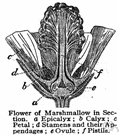ep·i·ca·lyx
(ĕp′ĭ-kā′lĭks, -kăl′ĭks)n. pl. ep·i·ca·lyx·es or ep·i·ca·ly·ces (-kā′lĭ-sēz′, -kăl′ĭ-)
A series of bracts subtending and resembling a calyx, as in the carnation and hibiscus.
American Heritage® Dictionary of the English Language, Fifth Edition. Copyright © 2016 by Houghton Mifflin Harcourt Publishing Company. Published by Houghton Mifflin Harcourt Publishing Company. All rights reserved.
epicalyx
(ˌɛpɪˈkeɪlɪks; -ˈkæl-)n, pl -lyxes or -lyces (-lɪˌsiːz)
(Botany) botany a series of small sepal-like bracts forming an outer calyx beneath the true calyx in some flowers
Collins English Dictionary – Complete and Unabridged, 12th Edition 2014 © HarperCollins Publishers 1991, 1994, 1998, 2000, 2003, 2006, 2007, 2009, 2011, 2014
ep•i•ca•lyx
(ˌɛp ɪˈkeɪ lɪks, -ˈkæl ɪks)n., pl. -ca•lyx•es, -ca•ly•ces (-ˈkeɪ ləˌsiz, -ˈkæl ə-)
a rosette of bracts that resembles an extra calyx, as in the mallow flower.
[1865–70]
Random House Kernerman Webster's College Dictionary, © 2010 K Dictionaries Ltd. Copyright 2005, 1997, 1991 by Random House, Inc. All rights reserved.
ThesaurusAntonymsRelated WordsSynonymsLegend:
| Noun | 1. |  epicalyx - a group of bracts simulating a calyx as in a carnation or hibiscus epicalyx - a group of bracts simulating a calyx as in a carnation or hibiscusbract - a modified leaf or leaflike part just below and protecting an inflorescence |
Based on WordNet 3.0, Farlex clipart collection. © 2003-2012 Princeton University, Farlex Inc.